|
Books Should Be Free Loyal Books Free Public Domain Audiobooks & eBook Downloads |
|
|
Books Should Be Free Loyal Books Free Public Domain Audiobooks & eBook Downloads |
|
Top Authors |
|---|
|
Book type:
Sort by:
|
By: Alexander Roberts (-1620) | |
|---|---|
 A Treatise of Witchcraft
A Treatise of Witchcraft
| |
 Ante-Nicene Christian Library: Translations of the Writings of the Fathers Down to A.D. 325
Ante-Nicene Christian Library: Translations of the Writings of the Fathers Down to A.D. 325
This collection is first in a series of writings from the ante-Nicene Fathers' works. This first collection includes all the so-called Infancy narratives from the New Testament Apocrypha. - Summary by KevinS | |
By: Alexander Russell Bond (1876-1937) | |
|---|---|
 Inventions Of The Great War
Inventions Of The Great War
“… this war was not one of mere destruction. It set men to thinking as they had never thought before. It intensified their inventive faculties, and as a result, the world is richer in many ways. Lessons of thrift and economy have been taught us. Manufacturers have learned the value of standardization. The business man has gained an appreciation of scientific research. The whole story is too big to be contained within the covers of a single book, but I have selected the more important and interesting inventions and have endeavored to describe them in simple language for the benefit of the reader who is not technically trained... | |
By: Alexander Schmemann | |
|---|---|
 Great Lent: A School of Repentance Its Meaning for Orthodox Christians
Great Lent: A School of Repentance Its Meaning for Orthodox Christians
| |
By: Alexander Scott Withers (1792-1865) | |
|---|---|
 Chronicles of Border Warfare or, a History of the Settlement by the Whites
Chronicles of Border Warfare or, a History of the Settlement by the Whites
| |
By: Alexander Shields | |
|---|---|
 A Hind Let Loose Or, An Historical Representation of the Testimonies of the Church of Scotland for the Interest of Christ. With the True State Thereof in All Its Periods
A Hind Let Loose Or, An Historical Representation of the Testimonies of the Church of Scotland for the Interest of Christ. With the True State Thereof in All Its Periods
| |
By: Alexander Smith (1830-1867) | |
|---|---|
 Dreamthorp A Book of Essays Written in the Country
Dreamthorp A Book of Essays Written in the Country
| |
By: Alexander Stewart (1764-1821) | |
|---|---|
 Elements of Gaelic Grammar
Elements of Gaelic Grammar
| |
By: Alexander Sutherland Neill (1883-1973) | |
|---|---|
 A Dominie in Doubt
A Dominie in Doubt
| |
By: Alexander von Humboldt (1769-1859) | |
|---|---|
 COSMOS: A Sketch of the Physical Description of the Universe, Vol. 1
COSMOS: A Sketch of the Physical Description of the Universe, Vol. 1
| |
 Cosmos: A Sketch of a Physical Description of The Universe: Introduction
Cosmos: A Sketch of a Physical Description of The Universe: Introduction
Friedrich Wilhelm Heinrich Alexander von Humboldt was a Prussian geographer, naturalist, explorer, and influential proponent of romantic philosophy. Many consider him to be the last of the great polymaths. After his death in 1859, the scientific world began to divide into separate disciplines, each with its own knowledgeable but narrowly defined experts. Humboldt’s mind encompassed all that was then known of nature in one great whole. He could well be considered the father of modern ecology and earth studies... | |
By: Alexander Walker | |
|---|---|
 Beauty Illustrated Chiefly by an Analysis and Classificatin of Beauty in Woman
Beauty Illustrated Chiefly by an Analysis and Classificatin of Beauty in Woman
| |
By: Alexander Wheelock Thayer (1817-1897) | |
|---|---|
 Life of Ludwig Van Beethoven, Vol. 1
Life of Ludwig Van Beethoven, Vol. 1
The first of three volumes of the first scholarly biography of Ludwig van Beethoven. Covers the years 1770-1802. - Summary by Zain Solinski | |
 Life of Ludwig van Beethoven, Volume I (Version 2)
Life of Ludwig van Beethoven, Volume I (Version 2)
The first scholarly biography on the life of Ludwig Von Beethoven. Volume 1 - Summary by Realisticspeakers | |
By: Alexander Whyte (1836-1921) | |
|---|---|
 Sir Thomas Browne and his 'Religio Medici' an Appreciation
Sir Thomas Browne and his 'Religio Medici' an Appreciation
| |
 Bunyan Characters Volume I
Bunyan Characters Volume I
This is the first volume of four which goes into the details of Characters from John Bunyan's books. This one is about characters of Pilgrims Progress. | |
 Jacob Behmen an appreciation
Jacob Behmen an appreciation
| |
 Samuel Rutherford and some of his correspondents
Samuel Rutherford and some of his correspondents
| |
 Bunyan Characters (3rd Series)
Bunyan Characters (3rd Series)
| |
 Bunyan Characters Volume II
Bunyan Characters Volume II
This is the second volume of four which goes into the details of Characters from John Bunyan's books. This one continues with the characters of Pilgrims Progress. | |
By: Alexander Wilmot (1836-1924) | |
|---|---|
 Poetry of South Africa
Poetry of South Africa
Alexander Wilmot was a Cape Town politician and Fellow of the Royal Geographical Society. He is the author of the History of the Zulu War 1879. Here he collects poetry from various sources in the Cape Colony, Natal, and the Transvaal. Summary by Larry Wilson. | |
By: Alexandre Corréard (1788-1857) | |
|---|---|
 Narrative of a Voyage to Senegal in 1816 Undertaken by Order of the French Government
Narrative of a Voyage to Senegal in 1816 Undertaken by Order of the French Government
| |
By: Alexandre Dumas (1802-1870) | |
|---|---|
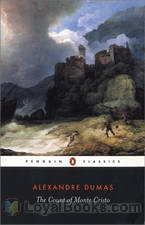 The Count of Monte Cristo
The Count of Monte Cristo
Written by French author Alexandre Dumas, The Count of Monte Cristo follows the life of Edmond Dantes as he embarks on a journey of revenge after being wrongly imprisoned and set up by none other than his so-called friends. Set during the years after the fall of Napoleon’s empire, the story unwinds in several locations including Paris, Marseilles, Rome, Monte Cristo and Constantinople. A handsome young sailor and soon to be ship captain Edmond Dantes seems to have it all in life, as he returns to Marseilles to wed the love of his life and fiancée, the beautiful Mercedes... | |
 The Three Musketeers
The Three Musketeers
The Three Musketeers follows the adventures of the young Gascon nobleman, D’Artagnan and his three trusted friends who served as musketeers in the king’s regiment – Athos, Porthos & Aramis. Written by Alexandre Dumas, the book was a bestseller during the time of its publication and it remains so even today. It follows the timeless theme of friendship and bravery. The main protagonist of the story is D’Artagnan who travels to Paris to realize his dreams of becoming one of the musketeers for the king... | |
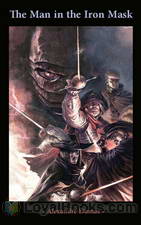 The Man in the Iron Mask
The Man in the Iron Mask
The Man in the Iron Mask by Alexandre Dumas is part of the novel The Vicomte of Bragelonne: Ten Years After, published in serial form between 1857-50. It is also the last of the D'Artagnan stories written by Dumas and the three musketeers are the real heroes of the story, though the title is given to the man in the iron mask. The story opens with Aramis (one of the musketeers who is now a priest) taking the last confession of a prisoner who is condemned to be executed soon. His confession comes as a thunderbolt to the former musketeer... | |
 Twenty Years After
Twenty Years After
First serialized from January to August, 1845, Twenty Years After is the second book in The D’Artagnan Romances, and follows the gallant adventures of the musketeers, as they are once again summoned to alleviate the various threats that lurk in the political scene of France, as the country is threatened by a possible uprising. Enriched with exciting and well-developed characters, the novel adds more detail to its familiar characters, as the musketeers have matured and are portrayed in a more introspective light... | |
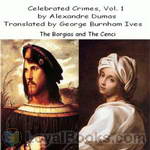 Celebrated Crimes
Celebrated Crimes
Dumas's 'Celebrated Crimes' was not written for children. The novelist has spared no language -- has minced no words -- to describe the violent scenes of a violent time.In some instances facts appear distorted out of their true perspective, and in others the author makes unwarranted charges. The careful, mature reader, for whom the books are intended, will recognize, and allow for, this fact.The first volume comprises the annals of the Borgias and the Cenci. The name of the noted and notorious Florentine family has become a synonym for intrigue and violence, and yet the Borgias have not been without stanch defenders in history... | |
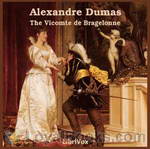 The Vicomte De Bragelonne
The Vicomte De Bragelonne
After The Three Muskateers and Twenty Years After the adventurous story of Athos, Porthos, Aramis and D'Artagnan continues!The Vicomte of Bragelonne: Ten Years Later (French: Le Vicomte de Bragelonne ou Dix ans plus tard) is the last of the Musketeer novels. It is usually divided into four volumes and this first volume contains chapters 1-75. | |
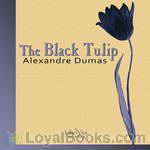 The Black Tulip
The Black Tulip
The Black Tulip, written by Alexandre Dumas père and published in 1850, is a historical novel placed in the time of Tulipmania in the Netherlands. The novel begins with the 1672 politically motivated mob lynching of the de Witt brothers and then follows the story of Cornelius van Baerle, godson of Cornelius de Wit. Cornelius Van Baerle has joined the race to breed a truly black tulip – and to win the prize of 100,000 guilders, as well as fame and honour. As he nears his goal he is jailed and then of course rescued – by the beautiful Rosa, daughter of the jailer. | |
 Louise de la Valliere
Louise de la Valliere
After The Three Muskateers and Twenty Years After the adventurous story of Athos, Porthos, Aramis and D'Artagnan continues! The Vicomte of Bragelonne: Ten Years Later (French: Le Vicomte de Bragelonne ou Dix ans plus tard) is the last of the Musketeer novels. It is usually divided into four volumes and this third volume contains chapters 141-208. | |
 Ten Years Later
Ten Years Later
After The Three Muskateers and Twenty Years After the adventurous story of Athos, Porthos, Aramis and D'Artagnan continues!The Vicomte of Bragelonne: Ten Years Later (French: Le Vicomte de Bragelonne ou Dix ans plus tard) is the last of the Musketeer novels. It is usually divided into four volumes and this second volume contains chapters 76-140. | |
 The Forty-Five Guardsmen
The Forty-Five Guardsmen
| |
 The Companions of Jehu
The Companions of Jehu
| |
 Marguerite de Valois
Marguerite de Valois
A historical fiction novel set in Paris (1572) during Charles IX's reign and the French Wars of Religion. Marguerite de Valois, daughter of deceased Henry II, is the novel's protagonist set against the infamous schemes of the Catholic power player, Catherine de Medici. | |
 Chicot the Jester
Chicot the Jester
This sequel to Dumas' “Marguerite de Valois” begins four years after the sudden death of King Charles IX and succession of his brother Henry III. The reign of King Henry III was plagued with rebellion and political intrigue due to the War of the Three Henries, where his regency was challenged by King Henry of Navarre (leader of the Huguenots) and Henry I, Duke of Guise (leader of the Catholic League). Dumas weaves two main storylines through this turbulent backdrop: one of the love ignited between le Comte de Bussy and la Dame de Monsoreau, and another of the friendship between King Henry III and his truly unique jester, Chicot (Jean-Antoine d'Anglerais). | |
 The Conspirators The Chevalier d'Harmental
The Conspirators The Chevalier d'Harmental
| |
 The Prussian Terror
The Prussian Terror
| |
 The Regent's Daughter
The Regent's Daughter
| |
 The Son of Clemenceau
The Son of Clemenceau
| |
 Man in the Iron Mask (an Essay)
Man in the Iron Mask (an Essay)
| |
 Celebrated Crimes, Vol. 7: Part 2: Countess de Saint-Geran
Celebrated Crimes, Vol. 7: Part 2: Countess de Saint-Geran
This story details the crimes and trial surrounding the unexpected pregnancy and subsequent childbirth of the Countess de Saint-Geran in 1640s France. Familial jealousies harbored by her sister-in-law, the Marchioness de Bouille, intertwine with the greedy schemes of a fugitive relative, the Marquis de Saint-Maixent, to produce a scandalous series of events. - Summary by jvanstan | |
 Celebrated Crimes, Vol. 7: Part 3: Murat
Celebrated Crimes, Vol. 7: Part 3: Murat
Amidst the political winds from Napoleon’s downfall, this tale turns our attention to the flight of a former French marshal and King of Naples, Joachim Murat. Murat, unhappy with the deal he made to obtain pardon from the Austrian Emperor, takes a life-ending resolution to retake his crown rather than live in peaceful obscurity. - Summary by jvanstan | |
 Celebrated Crimes, Vol. 8: Part 1: The Marquise de Brinvilliers
Celebrated Crimes, Vol. 8: Part 1: The Marquise de Brinvilliers
The crimes of the Marquise of Brinvilliers, a French aristocrat during the reign of Louis XIV, included some of the most famous murders, scandals and mysteries in French history. This story recounts her major crimes, torture, conviction and execution. - Summary by jvanstan | |
 Three Musketeers, Version 2
Three Musketeers, Version 2
D’Artagnan, son of a poor Gascon aristocrat, travels to Paris to seek his fortune. His family connections enable him to obtain a position in a Guard regiment. His provincial ingenuousness and his hot-headed sense of honor earn him three duels in as many hours. Thankfully, his preparation with the sword is sufficient to recommend himself to his Musketeer antagonists, and they – Athos, Porthos, and Aramis – become his fast friends. But fate also crosses D’Artagnan’s path with some dangerous people who become his opponents: a mysterious “man from Meung” and a woman who styles herself Milady, who has formidable seduction skills and a heart that is mean and violent... | |
 Celebrated Crimes, Vol. 8: Part 2: Vaninka
Celebrated Crimes, Vol. 8: Part 2: Vaninka
The story of Vaninka, generally regarded as the most fictionalized of Dumas’ Celebrated Crimes series, occurs during the short and eccentric rule of Emperor Paul I of Russia. Vaninka is a general’s daughter whose love for one of her father’s officers leads to tragic death, savage crimes and perversions of justice. - Summary by jvanstan | |
 Celebrated Crimes, Vol. 8: Part 3: The Marquise de Ganges
Celebrated Crimes, Vol. 8: Part 3: The Marquise de Ganges
The assassination of Diane de Joannis de Chateaublanc is a fitting tale to conclude Dumas’ celebrated crimes series. This event was as gruesome as it was brazen and, before the final dagger strokes, both the assassins and the assassinated had become embroiled in high-profile intrigues. As a result, it sent reverberations through common and court societies across Europe for decades. - Summary by jvanstan | |
 d'Artagnan Romances, Vol 1: The Three Musketeers (version 3)
d'Artagnan Romances, Vol 1: The Three Musketeers (version 3)
The d'Artagnan Romances are six volumes that intertwine exciting events from 17th-century Europe and the life of the most adored French musketeer of that period, Charles de Batz-Castelmore d'Artagnan. Volume 1 introduces d’Artagnan as a young man, seeking to earn the glory of serving in the King’s Musketeers. While in pursuit of this aim, d’Artagnan befriends three musketeers – Athos, Porthos, and Aramis – who aid him in adventures against their King’s adversary, the cunning Cardinal Richelieu. "One for all, and all for one!" - Summary by jvanstan | |
 d'Artagnan Romances, Vol 2: Twenty Years After (version 2)
d'Artagnan Romances, Vol 2: Twenty Years After (version 2)
Volume 2 of The d'Artagnan Romances begins twenty years after "The Three Musketeers." Since then, d'Artagnan's career has stagnated, he’s lost touch with his friends, and the high favor earned with Queen Anne has been forgotten. His misfortune mirrors that of France, now ruled by an ineffective miser, Cardinal Mazarin, who’s avarice fuels a rebellion. Moreover, England is mired in civil war! Can d’Artagnan do the seemingly impossible: reunite “The Inseparables,” save the Queen and young... | |
 d'Artagnan Romances, Vol 3, Part 1: The Vicomte de Bragelonne: Ten Years Later
d'Artagnan Romances, Vol 3, Part 1: The Vicomte de Bragelonne: Ten Years Later
Volume 3 of The d'Artagnan Romances is divided into three parts. The first begins in 1660, ten years after Volume 2, with d’Artagnan as Lieutenant of the King’s Musketeers. In this post, he is very near to achieving his dream and even nearer to his King, being young Louis XIV’s personal guard. Seeing first-hand how powerless the child King was, d’Artagnan resigns his illustrious, but dull, post to turn his sharp wit and sword toward another ambitious aim: restoration of the English monarchy... | |
 Taking the Bastile
Taking the Bastile
Pitou lost his mother when he was small. He was raised by a stern aunt who did not really love him. He starts knowing the world by going to service. How can this man, Pitou the Peasant go on to influence the whole state? How can he go on and take a part in the French revolution? Can his motivation, coming from what he did not have, be enough? - Summary by Stav Nisser | |
 Marie Antoinette Romances, Vol 5: The Countess of Charny
Marie Antoinette Romances, Vol 5: The Countess of Charny
This 5th volume of the Marie Antoinette Romances begins after the fall of the Bastille and the March on Versailles, which forced Louis XVI and his court to be escorted back to Paris. In Paris, political factions battle over the fate of the nation, the royal family, and anyone with royalist sympathies. Our heroes and our anti-heroes must navigate the blood-streaked landscape while keeping their necks out of the guillotine. All the while, the prophetic Balsamo urges on the revolution: "the quantity of blood which must be shed before the sun rises on the free world ... | |
 d'Artagnan Romances, Vol 3, Part 3: The Man in the Iron Mask (version 2)
d'Artagnan Romances, Vol 3, Part 3: The Man in the Iron Mask (version 2)
Volume 3 of The d'Artagnan Romances is divided into three parts. In this, the final part, d’Artagnan’s fortune is near its height; having become the illustrious Captain of the Musketeers, he is now the chief defender of King Louis XIV. Fortune has also smiled on his three companions: Aramis is a wealthy bishop and the powerful, secret Superior General of the Jesuit Order ; Athos is the premier nobleman of France; and Porthos becomes a Duke with the proud but garishly long-winded title of “du Vallon de Bracieux de Pierrefonds... | |
 Marie Antoinette Romances, Vol 1: Balsamo, The Magician
Marie Antoinette Romances, Vol 1: Balsamo, The Magician
This is the first volume of Dumas' Marie Antoinette Romances . This historical fiction chronicles the strange events surrounding the fall of the French monarchy and rise of revolutionaries so terrifying that the period is still called "The Reign of Terrors" . In this volume, a renowned magician, Count Alessandro di Cagliostro , employs various occult tactics, like hypnotism and necromancy, to gain state secrets. Balsamo claims to be plotting against the Bourbons, but one must wonder whether this 3000 year old sorcerer has an ulterior motive... - Summary by jvanstan | |
 Marie Antoinette Romances, Vol 2: The Mesmerist's Victim
Marie Antoinette Romances, Vol 2: The Mesmerist's Victim
This 2nd volume of the Marie Antoinette Romances continues the intrigues of "Balsamo, The Magician" and adds to them the schemes of philosophers and the stirrings of revolution. Balsamo carries on his occult tactics to weaponize the state secrets that he gained in the previous volume. A serious romance and illness takes root in the court of King Louis XV, convincing one of the leading philosophic minds of the era, Jean-Jacques Rousseau, that “the breath of heaven will blast an age and a monarchy.” - Summary by jvanstan | |
 Marie Antoinette Romances, Vol 3: The Queen's Necklace (Version 2)
Marie Antoinette Romances, Vol 3: The Queen's Necklace (Version 2)
This 3rd volume of the Marie Antoinette Romances begins a decade after the close of "The Mesmerist’s Victim” and is based on a real scandal in Louis XVI’s court, commonly called “The Diamond Necklace Affair.” In this volume, the plotting of a powerful occultist, Count Cogliostro , collides with the long-festering resentments of a previous royal house, Jeanne de Valois , a growing popular movement for sociopolitical reform, and a shrinking supply of bread. It is easy to see how converging... | |
 Marie Antoinette Romances, Vol 4: Taking the Bastile
Marie Antoinette Romances, Vol 4: Taking the Bastile
This 4th volume of the Marie Antoinette Romances begins several years after the close of "The Queen’s Necklace.” It describes the events leading up to and including the storming of the Bastile. Past plots of Count Balsamo to destroy the French monarchy are resurrected by the mysterious Dr. Gilbert – a student of Balsamo’s occult arts and the Enlightenment philosopher, Jean-Jacques Rousseau. Considered by many critics to be a highlight of the Marie Antoinette Romances, Dumas tells this quintessential story of the French Revolution through the lens of the people... | |
 Celebrated Crimes, Vol. 2: The Massacres of the South
Celebrated Crimes, Vol. 2: The Massacres of the South
Dumas's 'Celebrated Crimes' was not written for children. The novelist has spared no language--has minced no words--to describe the violent scenes of a violent time.In some instances facts appear distorted out of their true perspective, and in others the author makes unwarranted charges. The careful, mature reader, for whom the books are intended, will recognize, and allow for, this fact. | |
 Celebrated Crimes, Vol. 3: Mary Stuart
Celebrated Crimes, Vol. 3: Mary Stuart
The contents of these volumes of 'Celebrated Crimes', as well as the motives which led to their inception, are unique. They are a series of stories based upon historical records, from the pen of Alexandre Dumas, pere, when he was not "the elder," nor yet the author of D'Artagnan or Monte Cristo, but was a rising young dramatist and a lion in the literary set and world of fashion.The third volume is devoted to the story of Mary Queen of Scots, another woman who suffered a violent death, and around whose name an endless controversy has waged... | |
 Forty-Five Guardsmen
Forty-Five Guardsmen
The sequel to "Chicot the Jester" and final book of the "Valois Romances." This story begins six years after the famed "Duel of the Mignons" between the favorites of the courts of King Henry III and Henry the Duke of Guise . Dumas concludes his historical fiction on the War of the Three Henries while detailing the formation of the Forty-Five Guardsmen , following Chicot the Jester as he stays loyal to the failing regency of King Henry III, and continuing the story of Diana . - Summary by jvanstan | |
 Count of Monte Cristo (version 2)
Count of Monte Cristo (version 2)
The story takes place in France, Italy, islands in the Mediterranean and the Levant during the historical events of 1815–1838 (from just before the Hundred Days through the reign of Louis-Philippe of France). The historical setting is a fundamental element of the book. It is primarily concerned with themes of justice, vengeance, mercy, and forgiveness, and is told in the style of an adventure story. | |